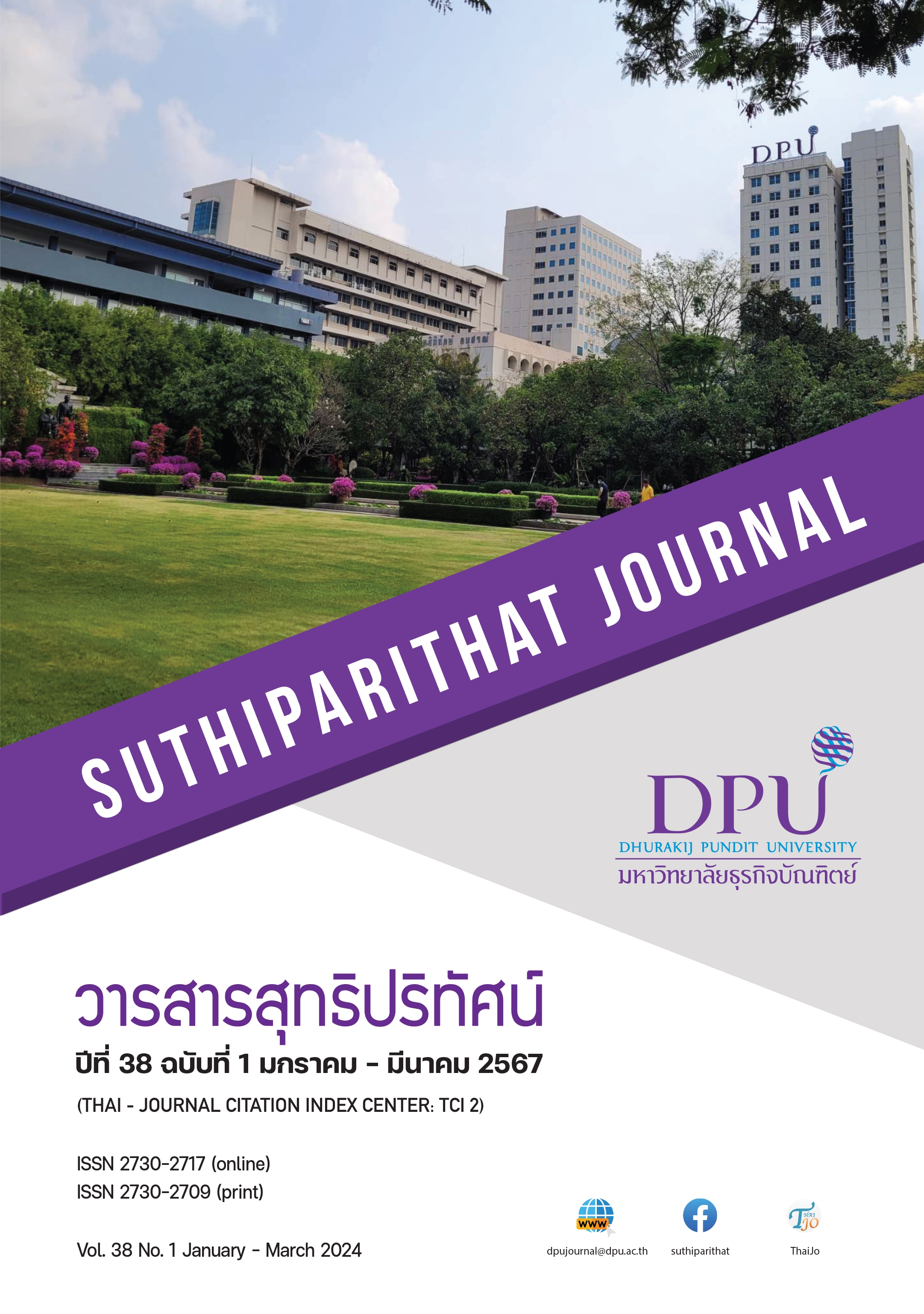ปัจจัยแรงจูงใจในการทำงานที่มีผลต่อการลาออกของพนักงานในภาคธุรกิจธนาคารพาณิชย์
คำสำคัญ:
ปัจจัยแรงจูงใจในการทำงาน, การลาออกของพนักงาน, สถาบันการเงินบทคัดย่อ
งานวิจัยเรื่อง ปัจจัยแรงจูงใจในการทำงานที่มีผลต่อการลาออกของพนักงานในสถาบันการเงิน มีวัตถุประสงค์เพื่อศึกษาปัจจัยแรงจูงใจในการทำงานที่มีผลต่อการผลต่อการลาออกของพนักงานในสถาบันการเงิน ในการศึกษานี้เก็บรวบข้อมูลโดยการแจกแบบสอบถามกับตัวอย่างจำนวน 355 คน ที่เป็นพนักงานประจำขององค์การ วิเคราะห์ข้อมูลด้วยสถิติการวิเคราะห์การถดถอยพหุคูณ การศึกษาพบว่าค่าเฉลี่ยของแต่ละตัวแปรแสดงให้เห็นว่าค่าตอบแทนเป็นปัจจัยแรงจูงใจในการทำงานที่มีผลกระทบมาที่สุด ( = 3.70) ตามด้วยประสบการณ์ (
= 3.38) และชั่วโมงการทำงาน (
= 3.26) นอกจากนั้น ยังพบว่า สมมติฐานได้รับการสนับสนุนบคือ ปัจจัยแรงจูงใจในการทำงานมีผลกระทบอย่างมากต่อการลาออกของพนักงาน อย่างมีนัยสำคัญทางสถิติที่ระดับ 0.001 R2 = 0.575. ซึ่งเป็นที่น่าสังเกตว่า ตัวแปรที่มีผลกระทบต่อการลาออกของพนักงานมากที่สุดคือ ค่าตอบแทน ผลการศึกษาครั้งนี้แสดงว่าปัจจัยทั้งหมดมีผลต่อการลาออกของพนักงาน แต่มีการประเมินในเชิงบวกที่ดีที่สุดคือ ค่าตอบแทนมีผลต่อความตั้งใจในการลาออกจากงาน เพราะเมื่อตรวจสอบส่วนประกอบของค่าตอบแทนที่พนักงานควรได้รับ หากมีความรู้สึกว่าไม่เท่าเทียมกับความสามารถของพวกเขาหรือลักษณะของงานที่พวกเขาทำ จะทำให้เกิดความไม่พอใจในค่าตอบแทนที่ได้รับ ความไม่พอใจนี้ส่งผลให้พนักงานต้องการลาออกและค้นหาโอกาสใหม่ในการทำงานที่มีค่าตอบแทนที่ดีกว่า
เอกสารอ้างอิง
Anderson, C. (2020). Strategies to retain employees within an organization [Doctoral dissertation, Walden University - Minneapolis]. Scholar Works Walden University. https://scholarworks.waldenu.edu/dissertations/8436
Babajide, A. A., Adegboye, F. B., & Omankhanlen, A. E. (2015). Financial inclusion and economic growth in Nigeria. International Journal of Economics and Financial Issues, 5(3), 629-637. https://www.econjournals.com/index.php/ijefi/article/view/1154
Benjamin, A., & Heywood, J. S. (2015). Performance pay and workplace injury: Panel Evidence. Economica, London School of Economics and Political Science, 82(s1), 1241-1260. https://onlinelibrary.wiley.com/doi/10.1111/ecca.12153
Biswakarma, G. (2016). Organizational career growth and employees’ turnover intentions: An empirical evidence from Nepalese private commercial banks. International Academic Journal of Organizational Behavior and Human Resource Management, 3(2), 10-26. http://dx.doi.org/10.5958/2249-7307.2015.00194.2
Böckerman, P., & Ilmakunnas, P. (2020). Do good working conditions make you work longer? Analyzing retirement decisions using linked surveys and registered data. The Journal of the Economics of Ageing, 17, Article 100192. http://dx.doi.org/10.1016/j.jeoa.2019.02.001
Geisler, J. (2021). The great resignation: Reality or myth? Healthcare Financial Management Magazine, 75, 44-45.
Green, F. (2004). Work intensification, discretion, and the well-being at work. Eastern Economic Journal, 30(4), 615-625. https://www.jstor.org/stable/40326152
Grmaldi, R. (2021). Employees should be paid what their work is worth, no matter their location. HR Magazine, 66, 29.
Hausknecht, J. P., Rodda, J., & Howard, M. J. (2009). Targeted employee retention: Performance-based and job-related differences in reported reasons for staying. Human Resource Management, 48(2), 269-288. http://dx.doi.org/10.1002/hrm.20279
Hsiao, J. M., & Lin, D. S. (2018). The impacts of working conditions and employee competences of fresh graduates on job expertise salary and job satisfaction. Journal of Reviews on Global Economics, 7, 246-259. http://dx.doi.org/10.6000/1929-7092.2018.07.22
Judge, T. A., Bono, J. E., & Locke, E. A. (2000). Personality and job satisfaction: The mediating role of job characteristics. Journal of Applied Psychology, 85(2), 237-249. http://dx.doi.org/10.1037//0021-9010.85.2.237
Kahn, W. A. (1990). Psychological conditions of personal engagement and disengagement at work. Academy of Management Journal, 33(4), 692–724. http://dx.doi.org/10.2307/256287
Klotz, A. C., & Bolino, M. (2016). Saying goodbye: The nature, causes and consequences of employee resignation style. Journal of Applied Psychology, 101(10), 1386-1404. http://dx.doi.org/10.1037/apl0000135
Krejcie, R. V., & Morgan, D. W. (1970). Determining sample size for research activities. Educational and Psychological Measurement, 30(3), 607-610. http://dx.doi.org/10.1177/001316447003000308
Kurniawaty, K., Ramly, M., & Ramlawati, R. (2019). The effect of work environment, stress, and job satisfaction on employee turnover intention. Management science letters, 9(6), 877-886. http://dx.doi.org/10.5267/j.msl.2019.3.001
Milkovich, G. T., Newman, J. M., & Gerhart, B. (2013). Compensation (11th ed.). McGraw-Hill Education.
Noe, R. A., Hollenbeck, J. R., Gerhart, B., & Wright, P. M. (2019). Human resource management: Gaining a competitive advantage. McGraw-Hill Education.
Quinones, M. A., Ford, J. K., & Teachout, M. S. (1995). The relationship between work experience and job performance: A conceptual and meta-analytic review. Personnel Psychology, 48(4), 887–910. http://dx.doi.org/10.1111/j.1744-6570.1995.tb01785.x
Saks, A. M., & Gruman, J. A. (2014). What do we really know about employee engagement? Human Resource Development Quarterly, 25(2), 155-182. http://dx.doi.org/10.1002/hrdq.21187
Setiorini, A., & Rachmarwi, W. (2020). Factors affecting job satisfaction and its effect on employee resignation in the Mulia Health and Dental Care (MHDC) Clinic Group. International Journal of Business Studies, 4(3), 135-145. https://www.academia.edu/73069996/Factors_Affecting_Job_Satisfaction_and_Its_Effect_on_Employee_Resignation_in_the_Mulia_Health_and_Dental_Care_MHDC_Clinic_Group
Soni, K., Chawla, R., & Sengar, R. (2017). Relationship between job satisfaction and employee experience. Journal of General Management Research, 4(2), 41-48. https://www.scmsnoida.ac.in/assets/pdf/journal/vol4issue2/04%20Kanika%20Soni.pdf
Wanger, S. (2017). What makes employees satisfied with their working time? The role of working hours, time-sovereignty and working conditions for working time and job satisfaction. IAB-Discussion Paper, No. 20/2017. http://hdl.handle.net/10419/172884
ดาวน์โหลด
เผยแพร่แล้ว
รูปแบบการอ้างอิง
ฉบับ
ประเภทบทความ
สัญญาอนุญาต
ลิขสิทธิ์ (c) 2024 มหาวิทยาลัยธุรกิจบัณฑิตย์

อนุญาตภายใต้เงื่อนไข Creative Commons Attribution-NonCommercial-NoDerivatives 4.0 International License.
เนื้อหาและข้อมูลในบทความที่ลงตีพิมพ์ในวารสารสุทธิปริทัศน์ ถือเป็นข้อคิดเห็นและความรับผิดชอบของผู้เขียนบทความโดยตรงซึ่งกองบรรณาธิการวารสาร ไม่จำเป็นต้องเห็นด้วย หรือร่วมรับผิดชอบใด ๆ
บทความ ข้อมูล เนื้อหา รูปภาพ ฯลฯ ที่ได้รับการตีพิมพ์ในวารสารสุทธิปริทัศน์ ถือเป็นลิขสิทธิ์ของวารสารสุทธิปริทัศน์หากบุคคลหรือหน่วยงานใดต้องการนำทั้งหมดหรือส่วนหนึ่งส่วนใดไปเผยแพร่ต่อหรือเพื่อกระทำการใด ๆ จะต้องได้รับอนุญาตเป็นลายลักษณ์อักษรจากวารสารสุทธิปริทัศน์ก่อนเท่านั้น







